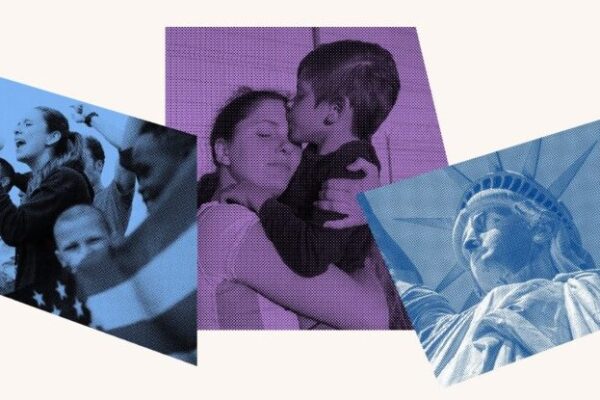In difficult times, I think about the things my dad taught me and how he spent his life working toward what most call the “American dream.” With hard work and determination, he was able to provide a better future for his family.
Like so many other immigrant parents, he worked hard to prepare me for the world. He taught me how to always be honest. “A man is only as good as his word,” he said. He taught me how to work hard. He knew some wouldn’t see us as equal, so he pushed me to work twice as hard because it was needed to be accepted. He showed me how to be resourceful, to always find a way to get the job done. And he taught me to never give up. No matter how high that mountain is, no matter how icy and hard it is to climb, we will climb it.
I love my dad and I am very proud of and grateful for the lessons and skills he taught me. Because of him, I was able to have access to more opportunities.
But despite what many people think, achieving the American dream as an immigrant isn’t easy – and there are widespread misconceptions about how the immigration system actually works. Legal pathways are narrow, costly, and often unavailable – even for those with U.S. citizen relatives or long-standing ties to the country. That’s why I want to share the common misconceptions about how the immigration system works.
Everyone Can Get a Green Card or Visa
The United Staes offers green cards through just a handful of narrow paths: refugee status, the diversity visa lottery, family or employer sponsorship, or for people with extraordinary skills or wealth. These options are either highly competitive, extremely limited, or out of reach for most people.
The diversity lottery, for example, only accepts a small number of applicants and excludes many countries entirely. Most family sponsorships have decades-long wait times. Employer-based green cards are usually reserved for people with advanced degrees. And marriage to a U.S. citizen doesn’t bypass the system – it requires financial sponsorship and, for those who entered unlawfully, can mean a three- or 10-year bar from re-entering the country.
The reality is that even when someone qualifies, long backlogs and strict caps often make immigration impossible. It’s not just difficult; it’s often not an option at all.
Being Undocumented is a Choice
It’s a common assumption that people who are undocumented have ignored legal paths. But we know that many legal paths to citizenship are, in fact, blocked, crowded or impractical. When someone’s survival is at risk, waiting years for a visa isn’t realistic. Many come because they have no other option – and they often try to fix their status later, only to face bans, income requirements, or rejection.
Around one in five undocumented people are Dreamers – brought here as young kids, raised in the U.S., and often unaware of their status until they’re older. For them, and for many others, being undocumented isn’t about ignoring the rules, it’s about surviving a system that offers no real way in to the only place they’ve ever known as home.
Marriage Guarantees Legal Status
There’s a common misconception that marrying a U.S. citizen automatically leads to legal residency. It doesn’t. The process is complicated, and for many, it’s filled with risks.
If someone entered the United States without a visa and stayed more than six months, they can be barred from returning for three or 10 years if they leave to attend their green card interview abroad. That puts families in an impossible situation: stay together without status or be separated for years. Even when the bars don’t apply, the process takes time, money, and documentation. The citizen-spouse must prove they can financially support their partner, and both must go through background checks, interviews, and legal filings.
Marriage can be a path, but it’s not simple, fast, or guaranteed. For many mixed-status couples, it’s a stressful, uncertain process with no clear outcome.
Immigration Policy Has Nothing to Do with Race
Much of today’s anti-immigrant rhetoric is rooted in fear of demographic change, especially when it comes to immigrants from nonwhite countries. Once a fringe belief, the “Great Replacement” theory – the idea that immigration is meant to undermine white political and cultural power – is now echoed in mainstream political messaging.
Terms like “invasion” have been used widely in political campaigns and media coverage, fueling fear and dehumanization. This kind of rhetoric shapes public opinion and justifies harmful policies, including mass deportations and family separations. If we want fair and humane immigration policies, we have to address how racism continues to shape the conversation.
“Too Many” Immigrants Sap Resources
Immigrants play a critical role in the U.S. economy and communities. They make up about 18 percent of the workforce, contribute more than $3 trillion to our gross domestic product, and pay more than $500 billion in taxes each year.
They also fill jobs in industries with ongoing labor shortages, like agriculture, construction, and elder care. In health care, immigrants make up a major share of doctors, nurses, and home health aides, keeping essential systems running, especially during crises like the COVID-19 pandemic. Beyond the labor force, immigrants open businesses, create jobs, and support public services through taxes. As the U.S. population ages, we’ll increasingly rely on immigrants to sustain economic growth and meet basic workforce needs.
These are not people taking from the country – they’re helping it move forward. Policies that restrict their ability to stay and contribute don’t just hurt them – they hold all of us back.
A version of this column also appeared in the Wyoming Tribune Eagle.


